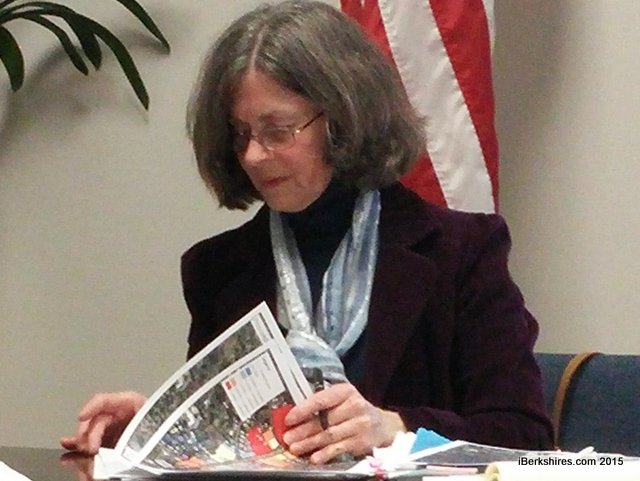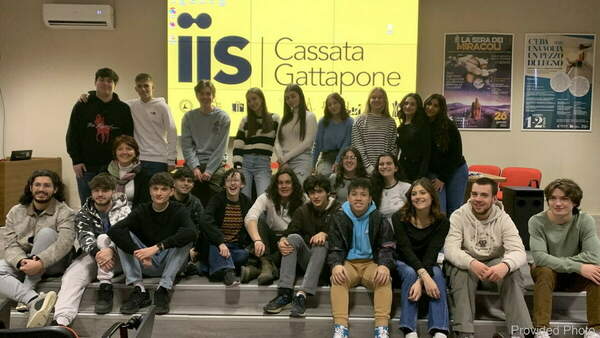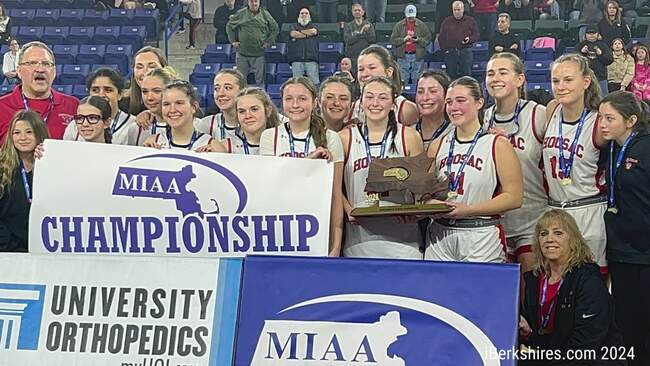Lenox Planners Debate Specificity of New Parking Regs
 Kate McNaulty-Vaughn reviews maps of the Lenox Historical District. Kate McNaulty-Vaughn reviews maps of the Lenox Historical District. |
LENOX, Mass. — Planners on Wednesday tweaked the new parking bylaw for historical and commercial districts as business owners voiced concerns over the repercussions of the anticipated changes.
"We're not the first town to eliminate our minimum parking standards in our downtown area," said Town Planner Gwen Miller. "It's been done in many communities in Massachusetts."
The Planning Board is proposing 45 new parking spaces (both on- and off-street), a more refined regulation bylaw, and better signage to direct people to municipal parking. While the proposed changes seem straightforward at a glance, Wednesday's meeting saw a debate between leaving the bylaw flexible and case-based, and offering specific guidelines to aid business owners.
"The changes ... were a response to some of the concerns heard at last week's public hearing and then discussions with town counsel, and some other stakeholders in the district [such as] property owners and other attorneys," Miller said, to outline the one major change made recently to the bylaw.
"The main issue that really came up is concern with the legality of allowing the building commissioner and town planner to make the decision in determining new parking standards, should a building require new spaces in the case of new construction."
Eyebrows were raised at the public hearing when people heard that the planning staff would have the same discretionary rights as the Zoning Board of Appeals. The Planning Board in response immediately developed a list of criteria that the staff would have to follow, and that would be used again by the ZBA should an appeals case arise.
Without specified criteria, explained Miller, "it raised the challenge of vagueness, saying that we could not be fair or replicable in our decision-making."
She and the other planners used established guidelines and common procedures to determine the criteria by which parking standards would be enforced, and especially considered intensity of usage of a building – which is a better way of determining parking requirements than simply going by square footage of a building.
"If someone is trying to do a building with multiple uses," she explained, "that gives the staff and the ZBA some discretion to say, 'we certainly don't think [for example, that] the ITE standards are suitable for this location, but here is something that could work and be more effective.'"
Kate McNaulty-Vaughn was the voice of structure, supporting the idea of more concrete numbers and specifically delineated requirements – to avoid that vagueness which was the board's main obstacle in finalizing the bylaw.
"This is a long [list] of ideas – it's a floating ship here, it doesn't seem to be tethered to anything," she objected. From her point of view, the bylaw needed to be more specific and less open to interpretation.
However, Chairman Kameron Spaulding held a different view.
"Is 'character of the community' defined? 'Increase in traffic' – is that defined? If they were defined items, we wouldn't necessarily need a ZBA. A lot of these numbers frame the debate, but if we add too many specifics, what you're actually doing is eliminating the need for a Zoning Board of Appeals."
Business owner Drew Davis preferred specificity over ambiguity – he asked the board to include "something to go on" so that property owners didn't have to spend the time and money hiring legal counsel and appearing before various committees just to find out what their individual requirements were.
But Spaulding reassured him that while strict guidelines weren't a part of the parking bylaw (or really, any of their other policies and bylaws), there was a system in place to give business owners the defined parameters they needed. For instance, if a property owner is adding more than 25 percent on to an existing building, he or she would need permits and site approvals anyway – and if the change was less than 25 percent, parking requirements would remain unchanged.
Another issue raised was that of proximity: most standard parking regulations hold businesses exempt that are within 400 to 500 feet of public parking. However, Miller informed the board, that did not apply to the Lenox Historical District. Instead, the margin was 1,000 feet: should a business be within that amount, it would be exempt from the bylaw's requirements.
"One thousand would make it so everyone in the district that we're proposing would be exempt, and within a clear distance of [public parking]. If you're doing the 400-500 in our district, you're really limiting who would benefit from that," said Miller.
"What you're going to lose is these fringe businesses," added Spaulding. "There would be eight buildings around the edge [of the historic district] that are lost."
In looking at the map of the commercial and historic district overlay, the board noticed these eight parcels were only partially within the boundary lines – though that was enough, according to Lenox law.
"If you're in at all, you're in," quipped Spaulding, emphasizing that any parcel that lay within the boundary of the historic district was included in that grouping.
McNaulty-Vaughn seemed incredulous at that, and suggested the board simply redraw the boundaries to fully include those partial properties – which the other members were supportive of doing, and made the change at that point.
(It was a small change, but geared toward clarity and efficiency.)
"What we have currently [versus] what we had a hundred years ago," she went on to say, "[is] commercial activities on Franklin Street but not Church Street, and then the houses have become businesses; we're not a Great Barrington, which obviously has a certain scale ... so how do we operate in a way that makes sense for our scale? Very complicated problem."
Miller was quick with a rebuttal, saying she had counted all the parking spaces in Lenox, which totaled around 845: "That includes 44 proposed municipal parking spaces that the town is going to be adding over the summer."
Great Barrington has between 900-1,000 parking spaces, in comparison.
Said Spaulding with some pride, "We would be comparable to the number of spots in Great Barrington, where there are far more businesses."
While more spaces is generally a good idea, Spaulding and Miller are advocating following a new trend in urban planning: that of only setting a maximum amount of parking spaces (to avoid paving too much land), and letting the market set the minimum.
"Too much parking then disrupts the urban fabric and really can cause pedestrian safety issues," assured Miller.
She also emphasized the untapped parking resources around Lenox (citing the Berkshire Bank public lot that was virtually empty at lunch hour), "and one of the prongs of our parking approach would be to have better wayfinding, to direct people to the available parking."
Spaulding agreed (as did the rest of the board and any business owner present) – he promised they were already working on designing new signage, which would complete the full picture of improved parking around historic Lenox.
Tags: bylaws, parking,















